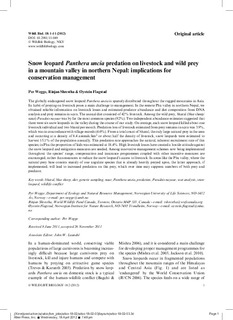| dc.contributor.author | Wegge, Per | |
| dc.contributor.author | Shrestha, Rinjan | |
| dc.contributor.author | Flagstad, Øystein | |
| dc.date.accessioned | 2018-07-26T18:34:00Z | |
| dc.date.available | 2018-07-26T18:34:00Z | |
| dc.date.created | 2012-06-26T09:29:29Z | |
| dc.date.issued | 2012 | |
| dc.identifier.citation | Wildlife Biology. 2012, 18 (2), 131-141. | nb_NO |
| dc.identifier.issn | 0909-6396 | |
| dc.identifier.uri | http://hdl.handle.net/11250/2506615 | |
| dc.description.abstract | The globally endangered snow leopard Panthera uncia is sparsely distributed throughout the rugged mountains in Asia. Its habit of preying on livestock poses a main challenge to management. In the remote Phu valley in northern Nepal, we obtained reliable information on livestock losses and estimated predator abundance and diet composition from DNA analysis and prey remains in scats. The annual diet consisted of 42%livestock. Among the wild prey, bharal (blue sheep/ naur) Pseudois nayaur was by far the most common species (92%). Two independent abundance estimates suggested that there were six snow leopards in the valley during the course of our study. On average, each snow leopard killed about one livestock individual and two bharal permonth. Predation loss of livestock estimated from prey remains in scats was 3.9%, which was in concordance with village records (4.0%). From a total count of bharal, the only large natural prey in the area and occurring at a density of 8.4 animals/km2 or about half the density of livestock, snow leopards were estimated to harvest 15.1% of the population annually. This predation rate approaches the natural, inherent recruitment rate of this species; in Phu the proportion of kids was estimated at 18.4%. High livestock losses have created a hostile attitude against the snow leopard and mitigation measures are needed. Among innovative management schemes now being implemented throughout the species’ range, compensation and insurance programmes coupled with other incentive measures are encouraged, rather than measures to reduce the snow leopard’s access to livestock. In areas like the Phu valley, where the natural prey base consists mainly of one ungulate species that is already heavily preyed upon, the latter approach, if implemented, will lead to increased predation on this prey, which over time may suppress numbers of both prey and predator. | nb_NO |
| dc.description.abstract | Snow leopard Panthera uncia predation on livestock and wild prey in a mountain valley in northern Nepal: implications for conservation management | nb_NO |
| dc.language.iso | eng | nb_NO |
| dc.rights | Attribution-NonCommercial-NoDerivatives 4.0 Internasjonal | * |
| dc.rights.uri | http://creativecommons.org/licenses/by-nc-nd/4.0/deed.no | * |
| dc.title | Snow leopard Panthera uncia predation on livestock and wild prey in a mountain valley in northern Nepal: implications for conservation management | nb_NO |
| dc.title.alternative | Snow leopard Panthera uncia predation on livestock and wild prey in a mountain valley in northern Nepal: implications for conservation management | nb_NO |
| dc.type | Journal article | nb_NO |
| dc.type | Peer reviewed | nb_NO |
| dc.description.version | publishedVersion | nb_NO |
| dc.source.pagenumber | 131-141 | nb_NO |
| dc.source.volume | 18 | nb_NO |
| dc.source.journal | Wildlife Biology | nb_NO |
| dc.source.issue | 2 | nb_NO |
| dc.identifier.doi | 10.2981/11-049 | |
| dc.identifier.cristin | 931542 | |
| cristin.unitcode | 192,14,0,0 | |
| cristin.unitname | Miljøvitenskap og naturforvaltning | |
| cristin.ispublished | true | |
| cristin.fulltext | original | |
| cristin.qualitycode | 1 | |

